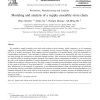Free Online Productivity Tools
i2Speak
i2Symbol
i2OCR
iTex2Img
iWeb2Print
iWeb2Shot
i2Type
iPdf2Split
iPdf2Merge
i2Bopomofo
i2Arabic
i2Style
i2Image
i2PDF
iLatex2Rtf
Sci2ools
EOR
2007
2007
Modeling and analysis of a supply-assembly-store chain
We consider a supply–assembly–store chain with produce-to-stock strategy, which comprises a set of component suppliers, a mixed-model assembly line with a constantly moving conveyor linking a set of workstations in series, and a set of product storehouses. Each supplier provides components of a specified family, which are assembled at a corresponding workstation. Units belonging to different models of products are sequentially fed onto the conveyor, and pass through the workstations to generate finished products. Each storehouse stores finished products belonging to a specific model for satisfying customer demands. The suppliers deliver components according to a just-in-time supply policy with stochastic leadtimes. Customer demands for a particular model of products arrive at the corresponding storehouse according to a Poisson stream. The paper conducts a modeling and performance analysis in the design stage of the system in the sense of ‘‘long-term-behavior’’. A roll...
| Added | 13 Dec 2010 |
| Updated | 13 Dec 2010 |
| Type | Journal |
| Year | 2007 |
| Where | EOR |
| Authors | Xiaobo Zhao, Deju Xu, Hanqin Zhang, Qi-Ming He |
Comments (0)

